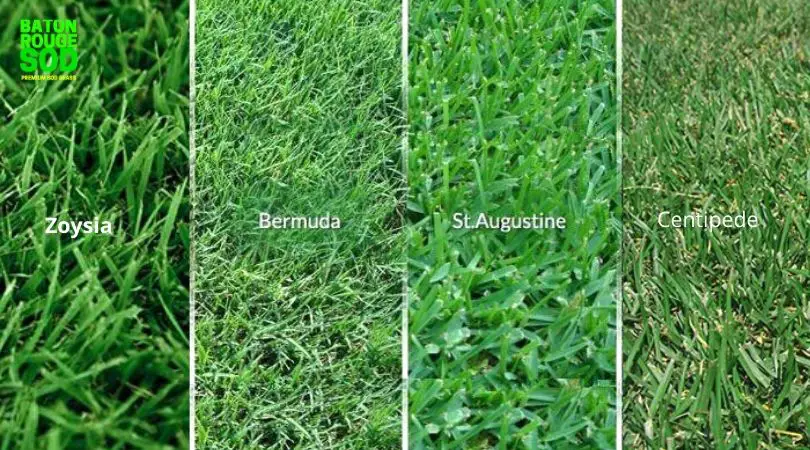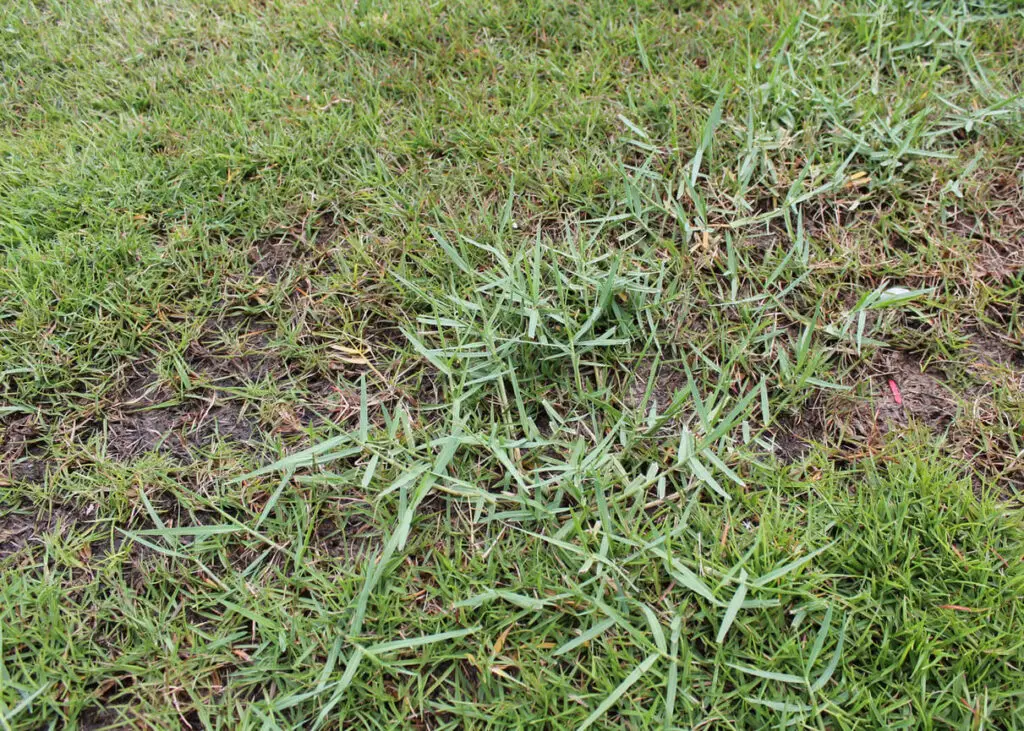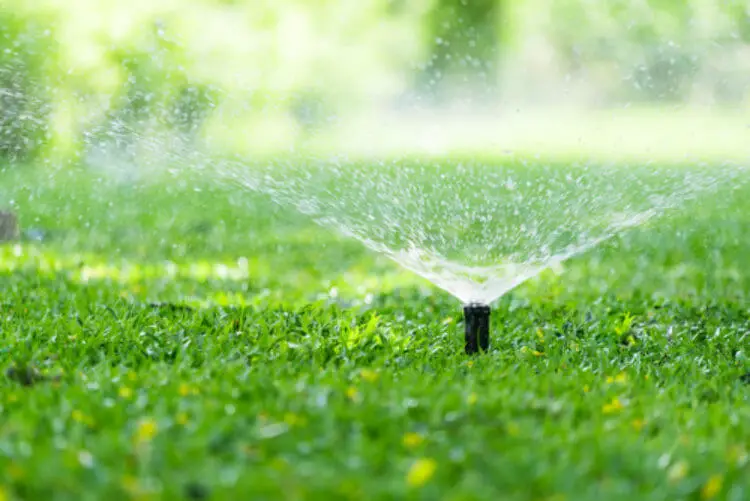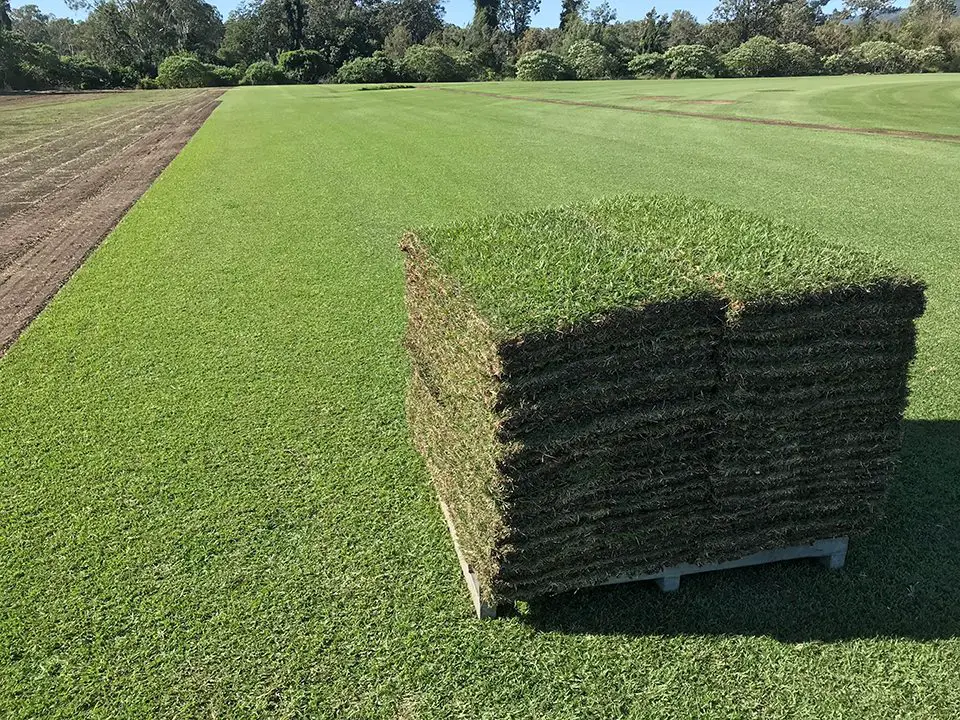What is the best lawn fungicide?
Lawn fungus is a problem that many property owners and managers have to deal with.
These fungi cause lawn turfgrass to turn brown and die in severe cases.
When fungus attacks a lawn, they can cause catastrophic damage, so fast action is necessary.
The go to products used to treat lawn fungus are fungicides.
Lawn fungicide is a pesticide used to manage different types of fungi.
This treatment is a useful tool in the arsenal of landscapers and yard enthusiasts to help to control fungus that damages lawns.
What Is Lawn Fungus?
Lawn fungus is a type of degenerative plant disease caused by fungi.
Fungi are a diverse group of microorganisms that proliferate quickly and debilitate the host.
Lawn fungus thrives in hot, humid climates and typically appears in late summer or early fall.
These fungi can grow almost anywhere, including soil, plants, and other organic materials.
Once lawn fungus infiltrates a yard, the symptoms appear as discolorations or unusual changes in the appearance of grass.
It causes circular or irregular-shaped patches of grass to turn brown, spreads quickly, and can easily overtake a lawn if not treated.
It damages the grass blades and makes them more susceptible to other environmental factors.
The resulting brown patches in the grass can be difficult to eliminate.
The fungus itself is not harmful to most plant species but can cause severely serious problems for turfgrass cultivars.
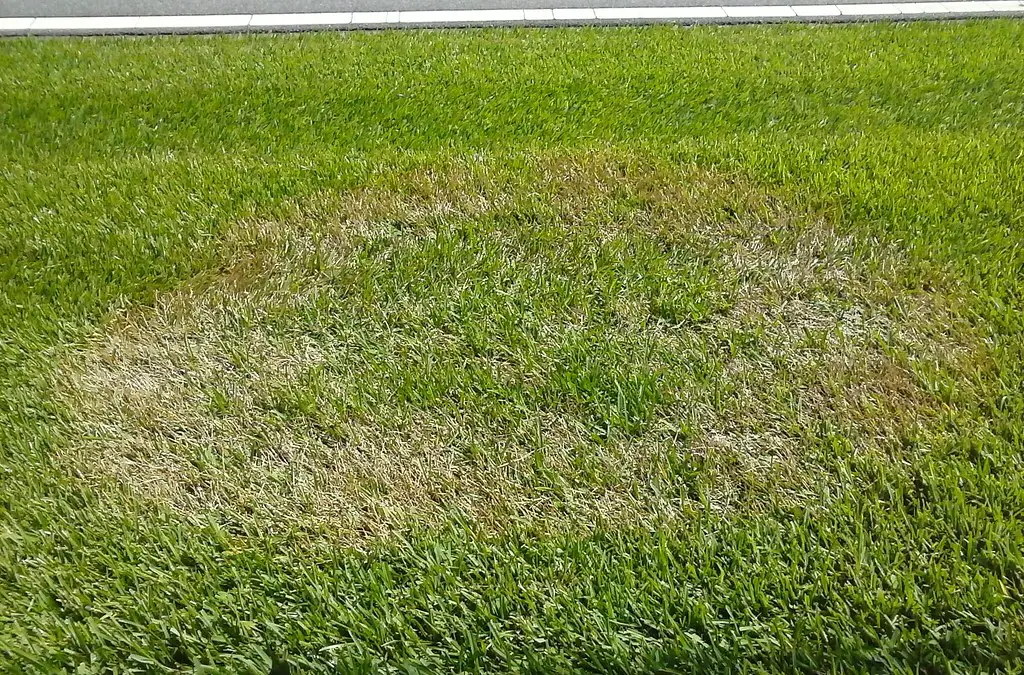
Brown Patch fungus in a front yard lawn
Types Of Lawn Fungus
There are three main types of lawn fungus that affect local lawns.
These are brown patch, dollar spot, and red thread.
Brown patch is most common in the southern United States, while dollar spot is most common in the northern United States.
Red thread is most common in the eastern United States.
Brown patch
Brown patch is a wdely icommon lawn fungus produced by the fungus species Rhizoctonia solani.
It is especially abundant in the summer months when it’s warm and humid.
Brown patch is distinguished by large circular areas of dead or dying grass encircled by a yellow or brown ring.
These patches can range in diameter from a few inches to several feet in diameter.
The center of the patch will be a healthy green, while the outer edge will be brown or yellow.
Grass blades within the affected area will be wilted and brown.
The symptoms of brown patch may include:
- Circular patches of dead or dying grass
- Yellow / brown ring of matter surrounding the patches
- Stunted or depressed grass growth
- Wilting and / or yellowing of grass blades.
Brown patch may potentially harm most grass varieties, although it is most frequent on cool-season grasses including Kentucky bluegrass, tall fescue, and perennial ryegrass.
Dollar spot
Dollar spot is a common lawn fungus produced by the fungus Sclerotinia homoeocarpa.
It is particularly abundant in the summer months and prefers warm, humid settings.
Dollar spot is distinguished by tiny, circular areas of dead grass encircled by a thin ring of yellow or brown grass.
The center of the spot may be white or light green.
The patches are often the size of a silver dollar, therefore the nickname “dollar spot.”
Common symptoms of dollar spot may include:
- Small, circular patches of dead grass
- Thin ring of yellow or brown grass surrounding the patches
- White or tan fungal growth on the blades of grass
- Stunted or slowed grass growth
Dollar spot may potentially harm most turfgrasses like St Augustine grass and Centipede grass; however it is more frequently found on cool-season grasses like Kentucky bluegrass and tall fescue.
Red thread
Red thread, also known as Pink patch, is a pinkish to red threadlike growth that often appears on lawns in early spring.
It is a fungal disease that affects turfgrass.
The disease causes the leaves of the grass to turn pink or red and then die.
The fungus that causes red thread can survive in the soil for many years, so it is essential to treat the disease early and regularly to kill the fungus effectively.
There are fungicides available to treat red thread; however, they work best when applied before the condition becomes severe.
It’s essential to diagnose the problem accurately.
Especially since other issues such as drought or insect damage can cause similar symptoms.
If you’re unsure what’s causing your lawn problems, you can take a sample of the affected turf to your local county extension office to get help with identification.
Symptoms Of Lawn Fungus
There are several things that can be done to prevent or treat fungus.
There are specific symptoms you can look for to determine if their grass is infected.
The symptoms of each type of fungus vary but generally include irregular patches of grass that are either discolored or dead.
The symptoms of fungus include a wilted appearance, dead patches, and browning of the blades.
If these patches are circular and have a defined edge, a fungal infection likely causes them.
Other signs of fungus include thinning grass, increased weed growth, and brown or discolored patches.
These types of fungus can be treated with fungicides, so it is important to identify the cause of the brown spots in your grass so that the correct fungicide can be used.
Dollar Spot fungus infestation in lawn
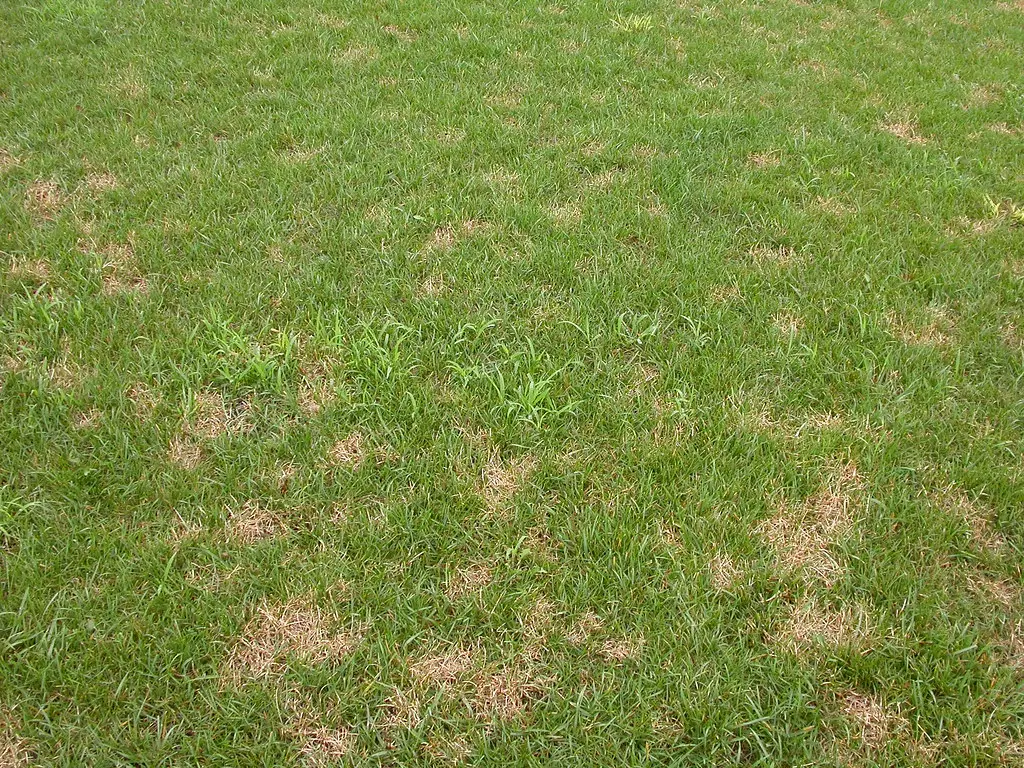
Dollar Spot fungus infestation in lawn
Now that you know what lawn fungus is, we can discuss options to get rid of them.
The easiest and most effective way to eliminate fungi is to us a fungicide.
What is Lawn fungicide?
Lawn fungicide is a type of pesticide used to kill or inhibit the growth of fungi on lawns.
These fungicides are used to treat fungal diseases.
It works by attacking the fungi’s life cycle and stopping them where they grow.
There are several types of fungicides on the market, each with its benefits and drawbacks.
Some common active ingredients in fungicides include copper, chlorothalonil, propiconazole, and azoxystrobin.
You can readily find liquids, granules, or pelleted form designed to treat your lawn
Lawn fungicides are explicitly made for grass, are available in liquid and granular forms, and can be applied using a garden hose or spreader.
What Is The Best Lawn Fungicide?
There are a few things to look for when trying to find the best lawn fungicide.
The first is the type of fungus you are trying to treat.
It should be effective against the specific fungus you are targeting.
Each of the most common types of lawn fungus brown patch, dollar spot, and red thread, requires a different approach when it comes to treatment.
Making a selection may be a little confusing since there are many different types of lawn fungicides available on the market today.
Some of the most readily available products include terbinafine, trifluralin, and mixtures thereof.
Another thing to consider is if it is safe for use around people and pets.
And finally, it should be affordable and easy to find.
Here are the top used and most effective products that we have actually used and tested.
Best Granular
We use The Anderson’s Prophesy the most. We also use Scott’s DiseaseEx as it’s easy to find and available at many locations.
Scotts Diseaseex Lawn Fungicide –
This is one of the best granular fungus treatment products. It’s effective, easy to find, and affordable.
- Cures 26 types of lawn diseases
- Protects lawns from Brown Patch, Stem and Stripe Rust, Red Thread, Powdery Mildew, Necrotic Ring Spot, Summer Patch, and Yellow Patch among common diseases.
- Starts working in 24 hours of treatment; the systemic fungicide formula controls common broad spectrum diseases for up to 4 weeks
- The fast acting formula starts working within 24 hours and helps combat broad spectrum disease for up to four weeks.
BioAdvanced 701230A
is the granular version with ready-to-spread Granules
The Andersons Prophesy Propiconazole Broad Spectrum Fungicide on DG Pro
- The Anderson’s Prophesy is a dependable broad spectrum, systemic disease control and suppression for turf grass lawns.
- Use this product as a pre emergent in a preventative disease control program.
- DG Pro formulation allows for more particles per square inch.
- The product dissolves when it comes in contact with water.
- The easy to spread formula with Dispersing Granual Technology leads to better application of fungus control.
Heritage G Fungicide –
Heritage is good, but requires specific application procedures. It is not always easy to find and not available in certain areas.
- Azoxystrobin 0.31%
- Golf courses, lawns and landscape areas around residential
- Commercial and industrial buildings,
- Parks, recreational areas and athletic fields.
Best Liquid
BioAdvanced Fungus Control for Lawns –
BioAdvanced 701270A Effective Fungicide with Disease Prevention Fungus Control for Lawns. comes in liquid with a hose end sprayer
- Protects against lawn diseases for up to a month
- Controls brown patch, dollar spot, red thread, rust, and multiple other diseases
- Systemic fungicide is absorbed by grass to provide rainproof protection.
- Treats up to 5,000 sq ft
Propiconazole 14.3% Fungicide –
the Best Lawn Fungus Treatment is a professional product. Read all instructions and make accurate measurements before you start applying it to your lawn.
- PROPICONIZOLE 14.3 provides economical, broad-spectrum disease control for cool and warm season grasses, trees, shrubs and flowers.
- It has a micro emulsion formula which produces less odor, better tank stability,
- The active ingredients are locally systemic, and are absorbed for long-lasting disease control.
- Excellent plant coverage and tank mix with most other fungicides.
- Used in many areas including plant nurseries, landscapes, turf, trees, and golf courses.
- Effective against rusts, pink and gray snowmolds, gray leaf spot, zoysia patch, dollar spot, summer patch, anthracnose, leaf Spot, brown patch, powdery mildew.
Dow AgroSciences 173917 Eagle 20EW Fungicide
- Prevents and controls more than 15 fungal diseases
- Well tolerated by popular turf and ornamental species
- Systemic fungicide that works from the inside out to protect new growth
- Controls Dollar spot, Brown patch, Anthracnose, Spring dead spot, Necrotic ring spot, Red thread, Leaf spot, Powdery mildew, Rusts, Zoysia large patch, Septoria leaf spot, Zonate Leaf Spot and more
- Turfgrass, Landscape Ornamentals, Greenhouse and Nursery Ornamentals, Apples, Stone Fruits and Grapes
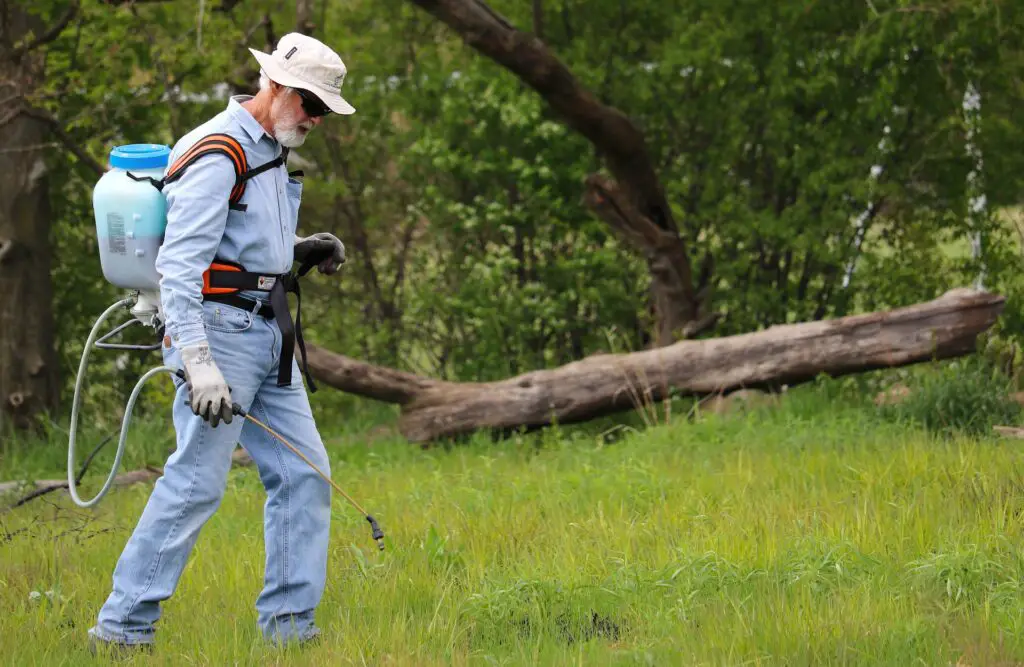
How To Treat Fungus With Lawn Fungicide
Several things can be done to prevent or treat brown patch fungus:
- Water the lawn deeply but infrequently. This will help create a healthy lawn less susceptible to fungus.
- Mow the lawn at the correct height. Taller grasses are more susceptible to fungus than shorter grasses.
- Apply a fungicide to the lawn if the fungus is detected. You can purchase fungicides at most hardware stores or garden centers.
In some cases, fungus can be controlled using natural methods such as increased watering and fertilization.
If you suspect your turfgrass has been infected with fungus, you should immediately take action.
The first step is to identify the cause of the infection.
You can do this by taking a sample of the affected grass and sending it to a laboratory for analysis.
Once the cause of the infection has been identified, a specialist can prescribe the appropriate treatment.
Infections can cause the grass to yellow and die.
The patches may also be itchy or sore if you walk on them barefoot.
The most important thing is to water your grass correctly.
You should water deeply, but not too often.
Overwatering can contribute to the development of fungus.
Another thing that you can do to help prevent lawn fungus is to mow regularly.
They are available as liquids, granules, or powders that can be applied using various methods, including hand-held or backpack sprayers, drop spreaders, and rotary spreaders.
How do you apply a lawn fungicide for best results?
Applying a lawn fungicide is important to keeping your lawn healthy and free of fungal diseases.
The benefits of using a liquid lawn fungicide
Using a liquid lawn fungicide can provide a number of benefits for lawns that are plagued by fungal diseases.
Not only is it easier to apply than granular fungicides, but it also offers faster absorption into the soil and superior coverage of the entire area.
The most important benefit associated with using liquid lawn fungicides is their immediate control over active outbreaks of fungus.
This quick action helps prevent the spread of disease and allows you to repair any damage done to your lawn in order to restore its health.
Liquid products are also more versatile because they can be easily mixed with other solutions, such as insecticides or fertilizers, in order to create custom treatments tailored specifically for your lawn’s needs.
Additionally, these treatments reach deeper into the roots in order to provide longer-lasting protection against future fungal outbreaks.
Pros of Liquid Lawn Fungicide:
1. Easier to spread over a larger area.
2. Quicker application time compared to granular fungicides.
3. Can be applied with a hose-end sprayer for convenience.
4. More precise application, making it easier to target affected areas.
5. Faster acting and may provide quicker relief from fungal infestation symptoms.
Cons of Liquid Lawn Fungicide:
1. Can be more expensive than granular fungicides in some cases.
2. May need to be reapplied more frequently due to shorter efficacy period compared to granules.
3. More prone to causing damage or harm if not applied correctly, as liquid can more easily reach unintended plants or areas of the lawn than granules can when blown off course by wind or water runoff from rain or irrigation systems.
4. Too much liquid fertilizer can cause runoff and leaching into groundwater, which is not good for plants and the environment.
The benefits of using a granular lawn fungicide
Using a granular lawn fungicide is the preferred option for many homeowners seeking to protect their lawns from fungus, disease and weeds.
Granular fungicides contain active ingredients that work by seeping into the soil and breaking down so that they can spread throughout your entire lawn.
This form of application provides superior coverage when compared to traditional liquid forms of fungicide, which can sometimes be difficult to spread evenly.
In addition to being more effective at covering a larger area, granular fungicides also offer several additional benefits.
One benefit is that it typically takes less time and labor to apply than its liquid counterpart due to its easy-to-use format.
The product itself is also often significantly cheaper than liquid forms, making it an economical choice for anyone looking to save money on their lawn care expenses.
Pros using a granular lawn fungicide:
1. Granular fungicides are easy to apply.
2. They provide protection for up to four weeks.
3. They’re effective at treating a variety of lawn diseases, including brown patch and dollar spot.
4. Granular fungicides can be inexpensive, depending on the brand and size of the product you purchase.
5. You can find granular fungicides in most home improvement stores or online.
Cons using a granular lawn fungicide:
1. Over-application of granular fungicides can cause burns and injury to your grass and other plants in your lawn.
2. The effects of the fungicide may not last as long as you expect, so more frequent applications may be necessary for full protection from disease-causing fungi.
3. It can be difficult to determine the exact amount of product needed for proper coverage of your lawn area due to variations in grass type and climate conditions in different areas around the
You can apply fungicides through a sprayer or by spreading them manually.
Be sure to read the product label carefully to ensure you apply the fungicide correctly and at the correct time.
Lawn fungicide is available in several different formulations, including pre-mixed and concentrates forms.
It should be applied when the temperature is above 64 degrees Fahrenheit and the relative humidity is above 80%.
If you are using a sprayer to apply, be sure to distribute the fungicide over the entire area being treated evenly. Avoid spraying in windy conditions, as this could cause the fungicide to drift and damage neighboring plants. Apply at least two inches of water to the area after spraying to help activate the fungicide and ensure it reaches all of the blades of grass.
If you are spreading fungicide manually, use a spreader to distribute it over the lawn evenly.
When to Apply lawn fungicide treatment?
There are a few things to consider when deciding when to apply a lawn fungicide treatment. The first is the weather; if it is going to be hot and humid, the fungicide will not work either. It is also essential to ensure that the fungus you are trying to treat is actually causing the problem on your lawn, as fungicides can be expensive and ineffective if used incorrectly. If you are unsure of what is causing your lawn problems, it is best to consult with a professional.
A good rule of thumb is to apply them every six weeks during the growing season.
How often should you apply it?
How often you need to apply a treatment will vary depending on the type of fungus, the climate, and the lawn condition.
You may need to apply a treatment every six to eight weeks during the growing season. You may need to apply a treatment more often if you live in a warm climate with high humidity. If your lawn is in good condition and has not been affected by fungus, you may only need to apply a treatment once or twice a year.
How To Prevent Lawn Fungus
Fungus can cause your lawn to turn yellow or brown, making your grass susceptible to other diseases. There are several things you can do to prevent fungus from taking over your lawn:
1. Water your lawn correctly. Over-watering can create the perfect environment for fungus to grow, so ensure you are watering your lawn only when it needs it.
2. Mow your lawn regularly. A short, healthy lawn is less likely to become infected with fungus than a long, shaggy one.
3. Apply fertilizer correctly. Excessive amounts of fertilizer can lead to fungal growth, so ensure you apply the recommended dose and follow the package instructions carefully.
4. Repair any damage caused by pests or animals as soon as possible.
The best way to prevent lawn fungus is to water your lawn correctly and mow it at the correct height. You can also use a fungicide to treat an infected turf.
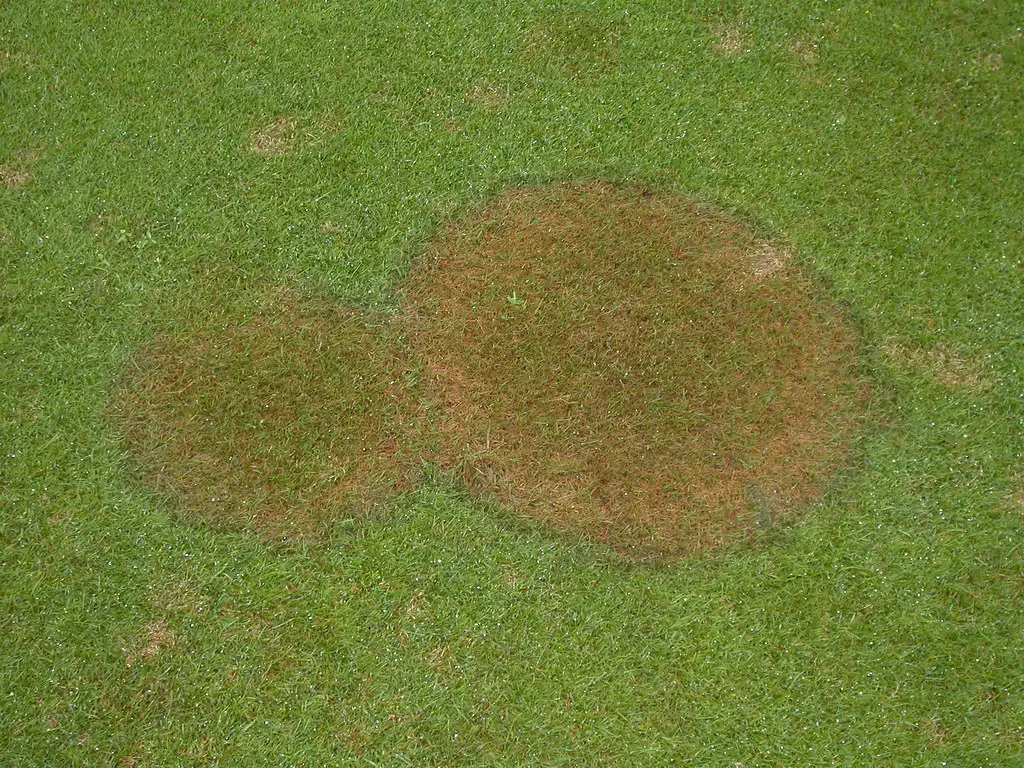
There are several ways to treat red thread. One way is to rake up the dead grass and dispose of it properly. Then, spray the lawn with a fungicide specifically for red thread. Be sure to follow the directions on the label carefully. Another way to treat red thread is to remove debris from around the base of the plants and then water deeply and regularly.
Lawn fungicide is used to treat fungal infections on lawns. You can use them in various ways. Spray on the lawn or use a granular product that is applied manually. Different types of fungi need additional treatment, so find the right fungicide for your lawn.
Additional Treatment options
For brown patch, for example, a fungicide with chlorothalonil is generally recommended.
Chlorothalonil can be found in many over-the-counter products such as Bayer Advanced Lawn Fungus Control or Bonide Fung-Away Lawn Disease Control.
For dollar spot, products containing propiconazole are usually effective.
Some good examples include Scotts Turf Builder Lawn Fungus Control and Bonide Infuse Systemic Disease Control.
For red thread a product containing myclobutanil is usually recommended.
Red thread grows in the thatch and creates red threads or cords that can be seen moving through the grass.
The fungus can kill the grass if it is not treated.
A good fungicide for red thread is a product that contains myclobutanil.
This product should be applied when conditions are favorable for the disease, typically in the early spring or late fall.
Myclobutanil will help to prevent the development of red thread and other fungal infections.
Treat red thread with a copper-based fungicide.
Copper-based fungicides are available as either a liquid or a powder, and they work by killing the fungus that causes red thread.
Liquid copper-based fungicides are more expensive than powders, but they’re easier to apply and provide better coverage.
If you’re using a liquid copper-based fungicide, mix it with water before applying it to your lawn.
Powdered copper-based fungicides are less expensive than liquid fungicides, and they’re also easier to apply.
Just sprinkle the powder on your lawn and water it in.
Preemergent herbicides such as oryzalin, benefin, and prodiamine can be applied in the spring before symptoms begin to appear.
Postemergence herbicides mecoprop can also be used to kill the fungus.
More Lawn Care Tips
What Are Those Brown Spots In My Yard
How To Get Rid Of Torpedo Grass
How To Measure Your Lawn For Sod
How Many Square Feet In A Pallet Of Sod?

